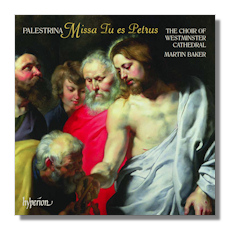
The Internet's Premier Classical Music Source
Related Links
-
Palestrina Reviews
Victoria Reviews - Latest Reviews
- More Reviews
-
By Composer
-
Collections
DVD & Blu-ray
Books
Concert Reviews
Articles/Interviews
Software
Audio
Search Amazon
Recommended Links
Site News
 CD Review
CD Review
Giovanni Pierluigi da Palestrina

Missa Tu es Petrus
- Giovanni Pierluigi da Palestrina:
- Mass "Missa Te Deum Laudamus"
- Motet "Tu es Petrus"
- Mass "Missa Tu es Petrus"
- Tomás Luis de Victoria: Motet "Te Deum laudamus"
Choir of Westminster Cathedral/Martin Baker
Hyperion CDA67785 77:49
The Choir of Westminster Cathedral, London, under its Master of Music, Martin Baker has a well-established reputation for the excellent performance of Renaissance choral polyphony. Idiomatic, stylish, expressive, they sing with an appropriate detachment and sang froid. This recording of two masses by Palestrina is no exception. The masses are preceded by Victoria's Te Deum as this is a setting of the chant on which the first work by Palestrina was based; it's a "paraphrase" mass.
The Missa, "Te Deum Laudamus" is set for SAATTB. The earliest extant manuscript we have for it dates from 1585, when it was copied into Codex 32 of the Papal Chapel; it formed part of the composer's ninth book of masses in 1599. A celebratory theme, it has very ancient origins; but the approach of the Choir of Westminster Cathedral balances due solemnity with gratitude. The result is a nicely uplifting tone.
The Missa, "Tu es Petrus" is also in six parts, SSATBB, and is a parody mass based closely on Palestrina's own motet (also sung here, [tr.8]) for the feast of St. Peter and St. Paul, which was first published in his second book of motets in 1572. It too is of a very upbeat tone and makes heavy use of antiphony. The singers convey exultation and senses of outward-facing joy as well as the certainty which reflects and respects the Biblical context of the motet. The even greater fugal writing in the Mass itself than the already quite extensive writing in that form in the motet lend its movements expansive and almost extrovert qualities. These the Choir have absorbed and communicate thoroughly – yet without the hint of "abandon" or undue extroversion.
All in all, this is a recording that suggests joy and celebration; but does so by the careful and idiomatic articulation of the texts, rather than by any (excessive) use of overt effects in the style of singing. Not that it lacks life at all. But it's focused and directed towards honoring the kind of relationship which one assumes must have existed between performers, church authorities and congregations in the sixteenth century.
The tempi are generally more sedate than excited. This is less a function of the fact that the Choir comprises nearly 30 voices in all. More of a purely artistic decision: the greater impact comes from a considered and patient approach to the way Palestrina matched music to text. In this case, as with all the recordings from Baker and his forces, it works very well.
The acoustic, Westminster Cathedral itself, is helpful in enforcing the nuances and forces of the music. It's a somewhat quiet recording; but easy to listen to. The booklet that comes with it has background and texts in Latin and English. Other recordings currently available are only of the Tu Es Petrus Mass – and all British. So this is the only place to get the Missa "Te Deum laudamus", which makes it very much something not to be hesitated over.
Copyright © 2010, Mark Sealey.





















